Notional Significance: Reclamation
[See all Notional Significance posts]
Kaiwharawhara is a node, a knot, a tangle of paths and histories. It’s where the eponymous stream meets the harbour, though quakes and reclamations have long since nudged the mouth seawards from its original position at the fault line, engulfing foreshore, shipwrecks and shellfish beds in the process. It’s where various incarnations of the Old Porirua Road peeled off from the Hutt Road, first lurching steeply up a precarious bridle track that followed the old Māori trails (keeping to the spurs and ridges where the bush was thinner), then clambering laboriously up the side of the gorge at a gradient better suited to bullock carts. True to etymology, much of the infrastructure is subterranean, pumps and transformers revealing the confluence of pipes and wires that gurgle and hum beneath the surface.
It’s also a place of broken connections. The Johnsonville line, twisting wearily up the gorge, was once part of the main trunk line, but railway arborists hacked the trunk back to a branch when the main line was diverted along the coast. The motorway rushes past, never stopping, but there are reminders of a junction that never was: the severed stumps of stillborn onramps. The river was once the edge of Wellington, where a hated tollbooth caught revenue for Hutt County until a municipal revolt led to the formation of the short-lived rebel borough of Onslow. Military history is also fugitive and redundant: the remnants of Fort Buckley skulk unseen on a spur, having never seen a Russian or a German ship; the Kaiwarra gunpowder magazine was Wellington’s oldest stone building until 2000, when a security van was torched after a botched heist, and it now lies in ruins.
The latest buildings and activities seem uncertain: transitional, temporary, placeless. Slick showrooms jostle with distribution hubs, mute retail boxes with petrolhead entertainments, Oriental rugs of dubious provenance with fine wines and overpriced sandwiches. A misshapen cartoon hound slobbers and gibbers above an intersection, keeping sightless vigil. Brick warehouses crowd around a narrow stream in a scene more at home in a Midlands canal district that a Wellington gorge. Revisiting the early days of dense settlement, houses of heartbreaking mediocrity scrabble up the ridge, a venal feeding frenzy, ravenous for marketable views. In a move that is dumbfoundingly crass even by developers’ standards, the streets are named after some of the writers that did the most to forge a distinctively New Zealand literary identity: Brasch Way, Sargeson Way (I wonder whether there’s a Frame Lane tucked around the back), Curnow Way. If this is the trick of standing upright here, maybe it’s time to sit down and think for a while.
But before I do that, I have some exploring to do. On the map, the Kaiwharahara Reclamation seems nothing more than a forgotten appendix on the highway’s flank, but it’s always intrigued me because it’s always eluded me. This time, I’m going to find a way there … even if it’s illegal. Railway and motorway form a seemingly impenetrable barrier, but the stream seems to offer a way through, a weakness in the defences. From the deserted central platform, I walk south into the chunky caramel-brown gravel. Signs make me paranoid, but guards and cameras seem mysteriously absent, so I exchange my faux-nonchalance for a quick dash across the tracks, over pipes and low barriers, and into the filthy darkness beside the river, just before the skyway meets the ground.
The undercroft is surprisingly spacious, but then again, there are not only six lanes of traffic but two abandoned ramps above me. I keep my eyes out for trolls and troglodytes, but all I find is signs of their passing: piles of damp rags, tagging, a graffito that reflexively defends its own cultural status (“this is art”) and a suspiciously clean mountain bike, complete with helmet, padlocked snugly into an alcove. I notice pentacles for the first time since The Terrace portal, and the cod-Satanic imagery extends to pitchforks and the fierce grimaces of half-formed demons.
The stream is rank and shallow, trickling defeatedly between concrete abutments, barely audible over the arrhythmic whoosh and clunk of the traffic overhead. When it emerges, it makes a fair attempt at emulating a natural river mouth, and the ducks, gulls and swans seem convinced enough by this ersatz estuary. But nothing is natural. Cables, pipes and rebar writhe out from the gravel, concrete slabs, asphalt shards, weathered bricks and drifting ash that constitute this Frankenstein’s peninsula. The land itself is treacherous underfoot — it shifts and crumbles, sinks and tilts — as if still bitter at its abandonment. It’s an arbitrary mélange of surplus matter, earth and rock and demolition detritus trucked from distant sites and dumped into the sea for some all-but-forgotten purpose, and now this land in exile has become an oubliette for the decaying leftovers of the transport industry.
Flaking gantries and charred timbers. Rails, ties and sleepers. Bald tires and burst boilers. Rust-streaked cuboid chambers the size of small apartments. Concrete blocks like toppled megaliths, falling into the slow embrace of fragrant weeds. All that effort went into reclaiming this land — the very word “re-claim” betrays our anthropocentric hubris, as if the seabed is rightfully ours and we have to claim it back from an ocean that outrageously absconded with it — and now it’s a land dedicated to forgetting.
Even these few acres of artificial promontory are enough to generate their own nanoclimates and a dense web of miniaturised ecosystems. Bijoux acacia forests, pocket deserts, clifftop colonies of flax and toetoe, lawn-sized meadows fringed by fennel and gorse. It’s an archetypal edgelands environment, neither urban nor natural, and the vegetation has attained the status of a cryptoforest: part self-seeded, part deliberate planting gone feral. Wilfried Hou Je Bek defines them thus: “Cryptoforests are sideways glances at post-crash landscapes, diagrammatic enclaves through which future forest cities reveal their first shadows, … psychogeographical camera obscuras of primal fear and wanton desire … What starts with weed ends with a cryptoforest, and in between there is survivalism, with plants eking out a living against all odds, slowly but determinedly creating the conditions for the emergence of a network of biological relationships that is both flexible and stubborn, unique and redundant, fragile and resilient.”
The sun slams down, and the wind can barely muster the strength to rustle the dry grasses. I slope back through the musty coolness of the motorway’s underworld, trudge across the tracks and make my way through carparks and lanes in search of a long-overdue beer. A billboard mutters “One second faster/One litre less”, then crows “Efficient/Dynamics//Sustainability for the real world”. Evidently, the “real world” is one in which sustainability comes not from rethinking our culture of excess, but from purchasing expensive German cars that are minutely less profligate with fossil fuels, yet still satisfy our lust for getting somewhere else as quickly as possible. Wake up, dreamers! The “real world” is one defined by laziness and shortsightedness, cupidity and stupidity.
Looking back across the simmering asphalt of the car yard, across the rust-red tracks and the restless traffic, I can just glimpse the bluff at the northern end of the Kaiwharahara Reclamation. On that crumbling artificial cliff, there once languished a billboard advertising the immense, yawning failure that was the Sesqui 1990 Carnival. Months passed; the hoarding gathered cobwebs and graffiti; and for a while the gateway to the capital was marked by this aching, hollow scrawl: “Spasqui: and I laughed and laughed and laughed”.

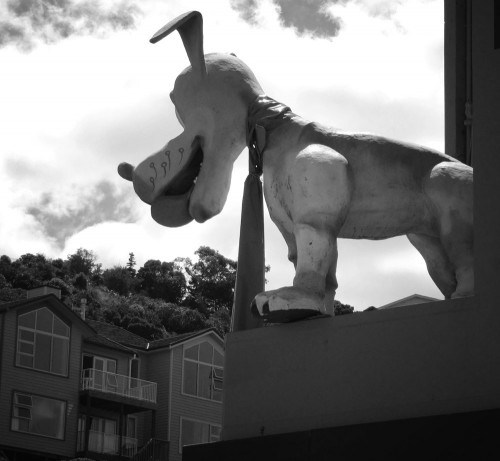
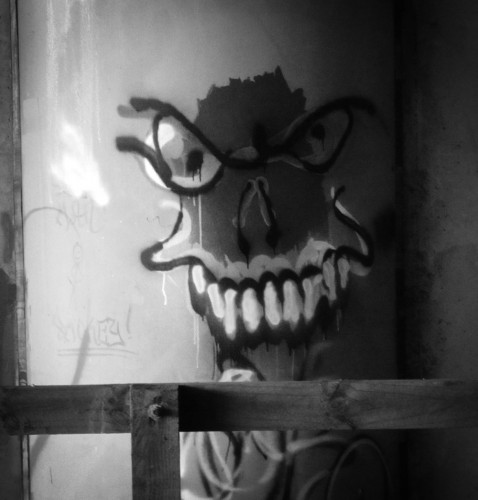
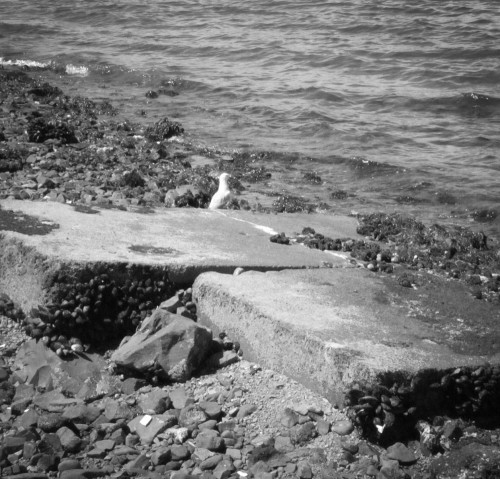
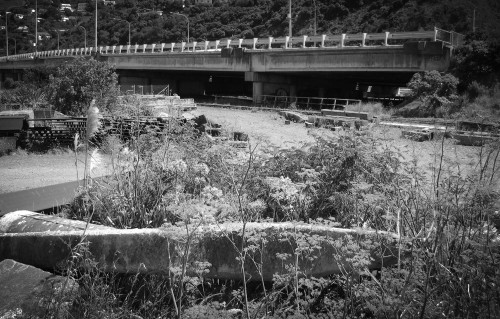
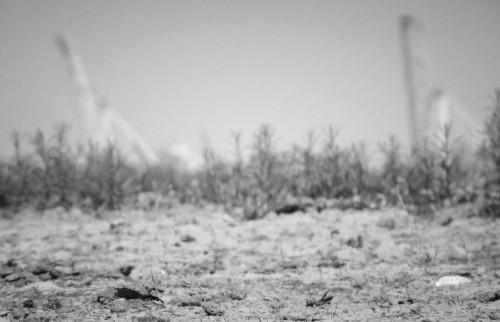
The Map of Notional Significance has been updated.
And bonus material: the National Library has a photo of the “Spasqui” billboards.